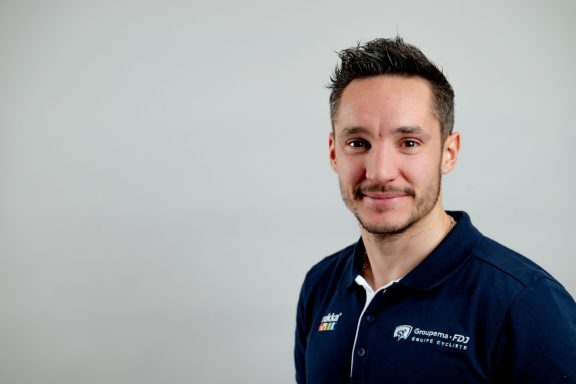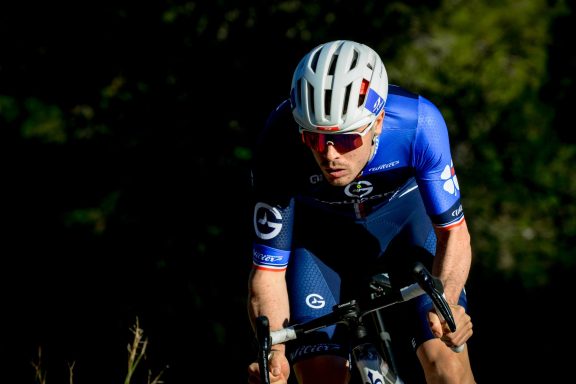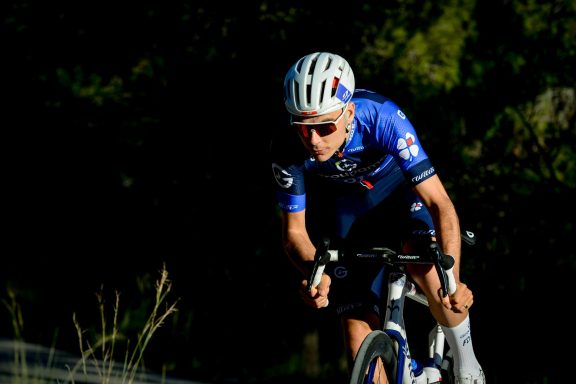A long-time specialist of the “Ardennes” Classics, Rudy Molard will be taking part in the 2021 campaign both as a protected and experienced rider. After a long break, the Frenchman will feature in a nice trio together with David Gaudu and Valentin Madouas. On the eve of the Amstel Gold Race, he sat down to tell us more about these races he’s so passionate about.
Rudy, you came back to racing this week after a month without competition. What have you been doing during this time?
After Tirreno-Adriatico, I took quite a long break as my program is based on the Ardennes Classics and the Giro. I really wanted to digest my first big block of racing, which I think was pretty good. I also got sick almost at the same time and I could not do any real training block for a little while. I was six days off the bike and then did a week with quite short rides. After that, I did a small training camp at home to prepare as well as possible for the rest of my program.
“I might be fresher, mentally and physically”
Your program therefore did not include the Tour of Flanders, though you particularly liked it last year…
I really wanted to go back there, because I was really disappointed to puncture last year while being in the group that fought for the podium. Unfortunately, it didn’t fit well into my program this year. If I had taken a break after the Ardennes Classics, I would have continued on Tirreno’s momentum, but knowing that I had the Giro afterwards, I absolutely needed a break at that time. If I had done the Tour of Flanders, I couldn’t have done that break as the Ardennes came right after. We had to make choices, reach compromises, and that meant skipping the Ronde. I hope to go back next year, and hopefully with the crowd, which would be even better.
On the other hand, you are now getting to a major period of your season.
The Ardennes Classics are obviously among my big goals for the year. That being said, I’m a little bit unsure about my condition, since I only raced De Brabantse Pijl in a month. I hope to get better and better and that my freshness will work in my favour. I have never experienced such an approach to the Ardennes Classics. Usually, I would do the Tour of the Basque Country beforehand. Having done only one race in a month is not ideal, but it might be enough. My doubt especially is about the last hour of racing. I tried to compensate for the Tour of the Basque Country in training, doing a great week of workloads so that I could be there in the finals. These races are won in the last hour, after six hours of racing. Racing upstream gives you the stamina to be there, while just training can make you come short in the end. Julien Pinot came to my place and we were able to work behind the scooter, which was pretty good. We’ll see how it goes. Usually, I’m closing a “shape” sequence in the Ardennes as I take a break right after. This time it’s the other way around. I’m really at the start of a sequence since I will go on the Giro after. Therefore, I might be fresher, mentally and physically. It can be an advantage.
Usually, what makes you think you’re ready?
When I can hold on short, explosive efforts, when I don’t come short and when my legs aren’t full with toxin after one minute or two to the limit. When I manage to resist the lactic acid for a long time, it’s usually a good sign for the Ardennes Classics. On the Brabantse Pijl (20th), it was not so bad. Being third of my group in a sprint, on a hill-top finish, for a returning race, is for instance a positive sign. I knew I wasn’t going to be completely in the mix anyway in my first race. Moreover, it was quite a special, dangerous race, with a lot of crashes. You needed to be positioned in specific spots to be there up front. You could get easily caught behind and you had to take a lot of risks.
“Liège-Bastogne-Liège is the one that gives me the most adrenaline”
The Ardennes Classics’ campaign starts this Sunday. Which one do you like the most?
It’s hard to say. I like all three because they are so different from each other. I like the Amstel because it is a much more open race than the others. At the start, a lot more riders can aim for the win and we don’t know what can happen. There are a lot of attacks in the final and that’s what makes it beautiful. On the Flèche, everything comes down to the last three minutes, and the strongest in these three minutes wins. It’s always the same scenario, it can be a bit boring, but it’s really a special race because it’s the only one of the season with this kind of finish. That’s what makes it beautiful in my opinion. I like this idea that we are many at the bottom and that the best wins at the top. That being said, everyone would name Liège-Bastogne-Liège as his favourite among those three. This is the “Old Lady”, the most prestigious one, the one everyone dreams of winning. It’s a Monument, and it is therefore above the other two, obviously. Personally, I preferred the legendary final with the Côte de Saint-Nicolas and the finish in Ans. Growing up I would watch the videos of this final, the Vandenbroucke-Bartoli battle in La Redoute and Saint-Nicolas, the attacks on the biggest chain ring… That’s what left a mark on me when I was young, and that was my dreaming course. It’s different now, but you have to move with the times, and Liège still is the most legendary of the three.
And which is the one that suits you the most?
The Flèche Wallonne is the one where I’ve been the most consistent. I almost always finished in the top 15-20 at the top of the Mur de Huy (6 times in the top-20) and this is also where I achieved my best performance among the three races (8th in 2017, editor’s note). This is the race I know the most, the one that I anticipate and read better. However, the one that gives me the most adrenaline is Liège, for sure.
What is the most important thing to have in mind starting each of these races?
For each of them, it’s more or less the same as far as I’m concerned. Mentally, I’m really focused on saving as much energy as possible for the last two hours of racing. I like to be more in the back of the bunch in the first part of the race, and then completely switched on in the second part. My purpose is really to get as fresh as possible in the end. Positioning is also very important, although it does not equal the one in the cobbles Classics. Let’s just say that in the Ardennes Classics, there are just 2-3 strategic places per race where you should pay attention, not more really.
“On the bike, we’re not bored at all”
Why do you think the audience generally prefers the Flemish Classics than the Ardennes ones?
In the Flemish Classics, the race really opens up early, but that’s because the course allows it. Once you’re up front, you can go far, and a lot of riders want to be one step ahead of the favourites. The course is very twisting, which also favours the breakaways. Everything is made for the race to start early on, and that’s what makes the Flemish Classics so great. I loved doing the Tour of Flanders myself. I watch it on TV every year if I’m not there, and I’m a big fan of this event. I don’t miss a kilometre. I can easily understand that people are more passionate about the Flemish Classics… It may also be less impressive and stunning to see the bunch reduce from the back. That also works for us, riders. As far as I am concerned, at least, I feel more adrenaline in the Ronde than in Liège, where riders just dropped from behind until La Roche-aux-Faucons. We can no longer attack in la Redoute… The teammates and the teams are so strong now that it gets difficult to attack. In the Flemish Classics, teamwork plays in a different way. With the numbers, Deceuninck-Quick Step will rather attack than pull, for instance. It is not like this in the Ardennes Classics, where the teams keep control until the last climb where the leaders are set to fight. Even if the organizers try to add new hills, it remains a waiting race, an attrition race. The leaders only go head to head for the last ten kilometers. This is no less than a WorldTour scenario, with a high pace you need to hold as long as you can. Still, on the Flèche for example, the time goes by quickly. There is a big fight for positioning, a lot of waves and many crashes. Everyone is trying to get the best position and that’s what makes the race stressful. On TV you may think that nothing is happening, but on the bike we are not bored at all.
The Amstel Gold Race will be raced in a circuit this year. What will that change?
They did one thing well: they didn’t put the Cauberg on the last lap. This will prevent a Flèche Wallonne-type of racing, where the leaders would have waited for the last climb to attack. Therefore, the race should open up earlier and that’s a good thing. This being said, I don’t think much will happen until the last three laps. The first part of the race might be a bit long and boring. Of course, we will climb the Cauberg twelve times, and that will inevitably cause fatigue, but I see more a championship-type of racing, which only explodes at the very end.
Does having competed in these races several times give you an advantage?
A bit, although everyone knows them now. Before Liège-Bastogne-Liège, all the teams do a recon. Everyone knows where they set foot and a lot of riders have competed in these races many times. However, since I haven’t done the Amstel very often, I have fewer landmarks. I may foresee the strategic spots a little less and I can still be surprised while I have quite reliable landmarks on the other two. With the recons and the races, I’ve done these courses a lot of times anyway.
“I am now a bit disappointed when I finish fifteenth”
You have nine top-20 and one top-10 under your belt in these races. What do you need more to aim a little higher?
Not much… In Liège last year, I was sixth at the top of Roche-aux-Faucons and I came to the line playing 6th place as well. Unfortunately, I completely missed my sprint. I got thirteenth while I had a really good opportunity to get into the first ten. I was really angry with myself because I had been looking for that top-10 for a while. I finished sixteenth in my first participation, for my second year pro. Since that day, I feel that I can do better. I need a bit of luck and a few extra watts. Everything has to go right, I have to do a perfect ride. I feel like I’m capable of getting into the top ten, I just need to have a great day. I am now a bit disappointed when I finish fifteenth. I really want to do better than that. My goal is always to improve my best result in the race. Consistency is certainly my strength, but in these races, it is better not to be consistent and to be on the podium or in the top 5 every 2-3 years than to be between 10th and 15th every year. Anyway, I still believe I can do it. I feel like I’m getting better and better and that my level is improving, but so is the overall level of the bunch. That’s also why it is not easy to get the best results.
Do you have specific goals for the three upcoming races?
For the three of them, the goal is a top 10. However, looking at the shape of David, we might go all-in for him in the Flèche. Personally, I’m thinking about the top-10s, but I’m putting less pressure on myself than in the past. Before I used to tell myself: “these are your races, you must be there”. Now, I go there knowing what I’m capable of, with more peace of mind than pressure. I actually would like to take more risks rather than just waiting. Unfortunately, you have to be patient in these races if you want to achieve a result. It’s sometimes frustrating to be there, close to the very best, showing a good level, but just lacking a little something to fight for the first places. However, I try to be satisfied with my performance level.
Is every single one of these races a goal for the team?
Absolutely, especially since we can perform well on all three! The team has got a good momentum, and we can surely get results together with David and Valentin. The team is now more focused on the Ardennes Classics than in the past, when they were more thinking about the Flemish ones. These days, the team is investing a lot more and there are therefore more expectations surrounding us in these races. Obviously, when we feel that the team is supporting us, we want to do well. And I think we can, considering the riders we have.
“You feel stronger when you have the numbers than if you’re alone”
Why is it an advantage to have three cards on the startling line?
In the Ardennes Classics, it is better to have several cards just because you don’t know what can happen, and you can quickly suffer from a bad day. Having three cards that can be up front means you have three opportunities to be there. We’ll try to use them in a smart way and do things right. In the final of Liège for example, if David is in front, I don’t have to pull behind. On the contrary, if David is a little behind, I can drop back a bit to bring him back. Having the numbers in the final can have an impact. The slightest dose of energy you’re able to save because you don’t need to pull can change the whole final. It’s also motivating to see that we are many from the same team with the best at the end. You feel stronger than if you are alone. Also, since we might come short in case of a sprint, especially in Liège, we’ll have the will to attack in these races. The three of us are really motivated.
What do you think a successful Ardennes Classics’ campaign would be?
For the team, I think a really successful campaign would be to achieve a podium in one of the three races. Personally, let’s say it would be a very successful campaign with a top 5 on one of the three, and just a successful one with a top 10…
You’ll start to think about the Giro only after?
I’m fully committed to my Ardennes Classics’ campaign right now, but I’ve been thinking about the Giro for a while. It’s been a goal since this winter, and even during my preparation, I was thinking as much of the Giro as of the Ardennes Classics. It also enables me to take the pressure off a little. Mentally, it’s also good to be able to see further, it allows me not to have complexes in these races. I am 100% focused on the Ardennes Classics but I still have a little thought for the future. I loved doing the Giro in 2017 and haven’t done it again since. I’m really happy to go there. Now you have to do everything in due time. Besides, performing here would be an ideal springboard for the Giro…



No comment